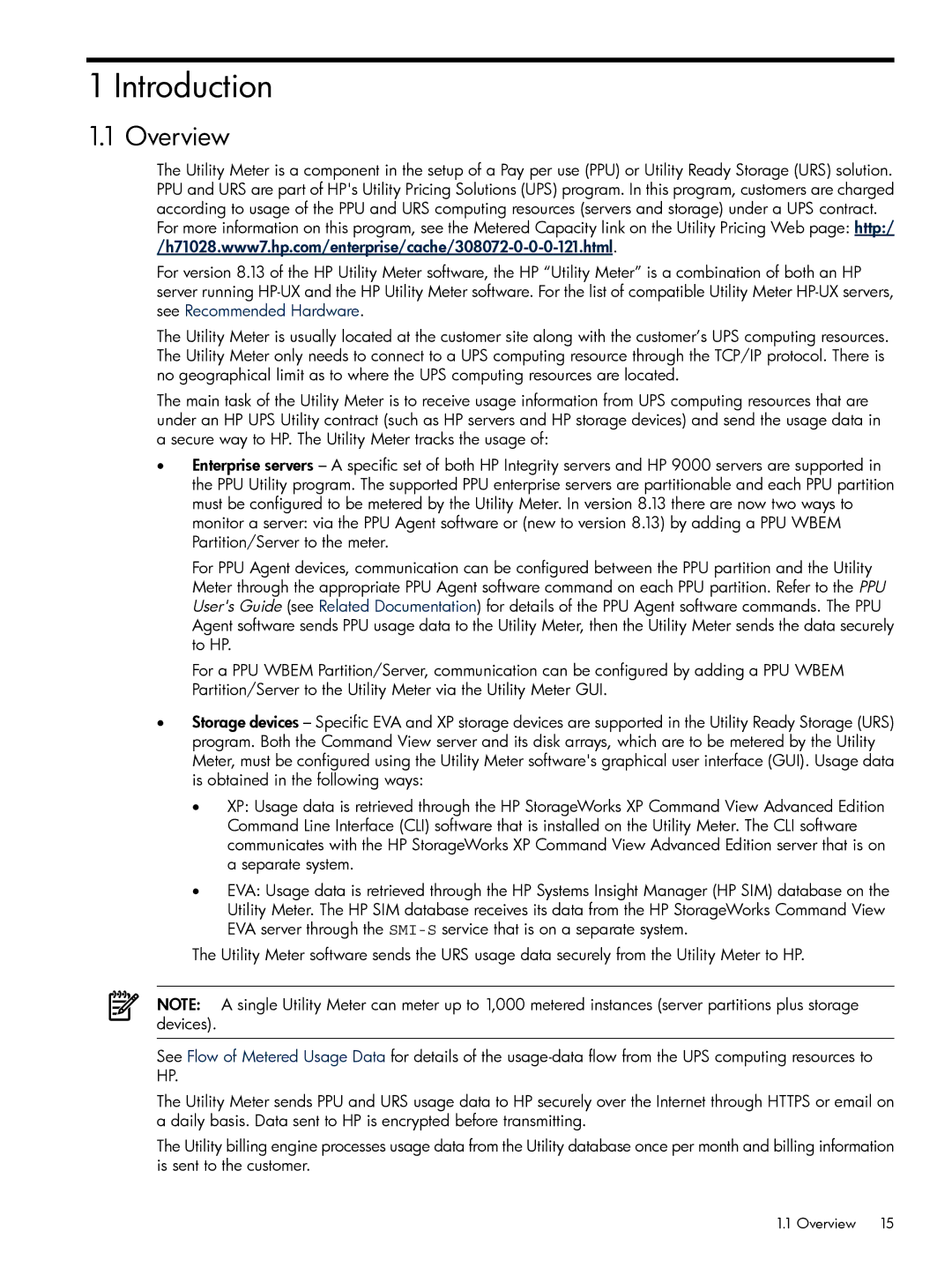
1 Introduction
1.1 Overview
The Utility Meter is a component in the setup of a Pay per use (PPU) or Utility Ready Storage (URS) solution. PPU and URS are part of HP's Utility Pricing Solutions (UPS) program. In this program, customers are charged according to usage of the PPU and URS computing resources (servers and storage) under a UPS contract.
For more information on this program, see the Metered Capacity link on the Utility Pricing Web page:
For version 8.13 of the HP Utility Meter software, the HP “Utility Meter” is a combination of both an HP server running
The Utility Meter is usually located at the customer site along with the customer’s UPS computing resources. The Utility Meter only needs to connect to a UPS computing resource through the TCP/IP protocol. There is no geographical limit as to where the UPS computing resources are located.
The main task of the Utility Meter is to receive usage information from UPS computing resources that are under an HP UPS Utility contract (such as HP servers and HP storage devices) and send the usage data in a secure way to HP. The Utility Meter tracks the usage of:
•Enterprise servers – A specific set of both HP Integrity servers and HP 9000 servers are supported in the PPU Utility program. The supported PPU enterprise servers are partitionable and each PPU partition must be configured to be metered by the Utility Meter. In version 8.13 there are now two ways to monitor a server: via the PPU Agent software or (new to version 8.13) by adding a PPU WBEM Partition/Server to the meter.
For PPU Agent devices, communication can be configured between the PPU partition and the Utility Meter through the appropriate PPU Agent software command on each PPU partition. Refer to the PPU User's Guide (see Related Documentation) for details of the PPU Agent software commands. The PPU Agent software sends PPU usage data to the Utility Meter, then the Utility Meter sends the data securely to HP.
For a PPU WBEM Partition/Server, communication can be configured by adding a PPU WBEM Partition/Server to the Utility Meter via the Utility Meter GUI.
•Storage devices – Specific EVA and XP storage devices are supported in the Utility Ready Storage (URS) program. Both the Command View server and its disk arrays, which are to be metered by the Utility Meter, must be configured using the Utility Meter software's graphical user interface (GUI). Usage data is obtained in the following ways:
•XP: Usage data is retrieved through the HP StorageWorks XP Command View Advanced Edition Command Line Interface (CLI) software that is installed on the Utility Meter. The CLI software communicates with the HP StorageWorks XP Command View Advanced Edition server that is on a separate system.
•EVA: Usage data is retrieved through the HP Systems Insight Manager (HP SIM) database on the Utility Meter. The HP SIM database receives its data from the HP StorageWorks Command View EVA server through the
The Utility Meter software sends the URS usage data securely from the Utility Meter to HP.
NOTE: A single Utility Meter can meter up to 1,000 metered instances (server partitions plus storage devices).
See Flow of Metered Usage Data for details of the
The Utility Meter sends PPU and URS usage data to HP securely over the Internet through HTTPS or email on a daily basis. Data sent to HP is encrypted before transmitting.
The Utility billing engine processes usage data from the Utility database once per month and billing information is sent to the customer.
1.1 Overview 15
